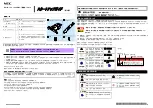
16–Configuring Teaming in Windows Server
Load Balancing and Fault Tolerance
234
83840-546-00 E
Load Balancing and Fault Tolerance
Teaming provides traffic load balancing and fault tolerance (redundant adapter
operation when a network connection fails). When multiple Ethernet network
adapters are installed in the same system, they can be grouped into teams,
creating a virtual adapter.
A team can consist of two to eight network interfaces, and each interface can be
designated as a primary interface or a standby interface (standby interfaces can
be used only in a
“Smart Load Balancing and Failover” on page 235
type of team,
and only one standby interface can be designated per SLB team). If traffic is not
identified on any of the adapter team member connections due to failure of the
adapter, cable, switch port, or switch (where the teamed adapters are attached to
separate switches), the load distribution is reevaluated and reassigned among the
remaining team members. If all of the primary adapters are down, the hot standby
adapter becomes active. Existing sessions are maintained and there is no impact
on the user.
Types of Teams
The available types of teams for the Windows family of operating systems are:
Smart Load Balancing and Failover with Auto-Fallback Enabled (SLB)
Link Aggregation (802.3ad)
Generic Trunking (FEC/GEC)/802.3ad-Draft Static
SLB (with Auto-Fallback Disable)
NOTE
Although a team can be created with one adapter, it is not recommended
since this defeats the purpose of teaming. A team consisting of one adapter
is automatically created when setting up VLANs on a single adapter, and this
should be the only time when creating a team with one adapter.
Summary of Contents for FastLinQ 3400 Series
Page 286: ......
















































